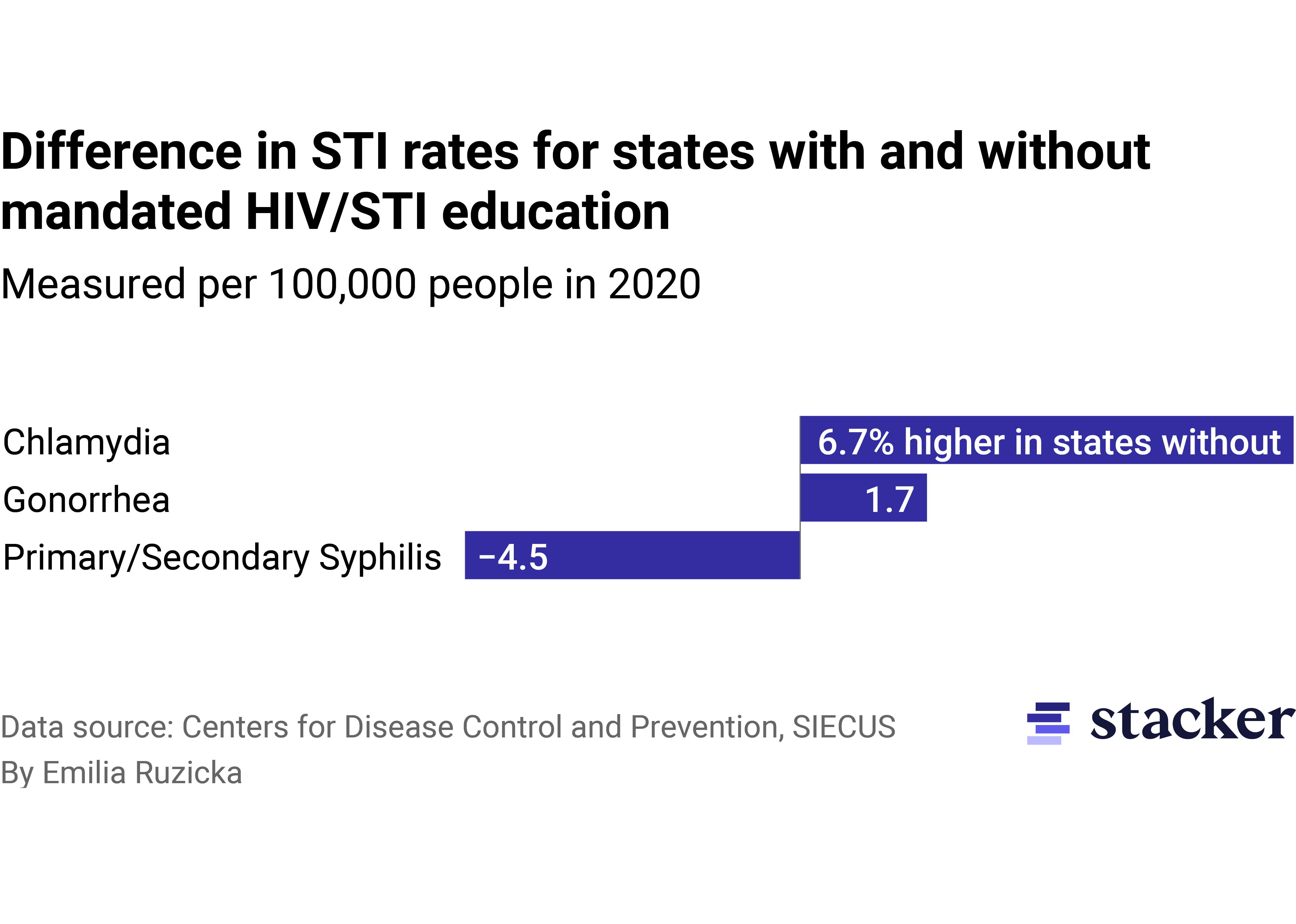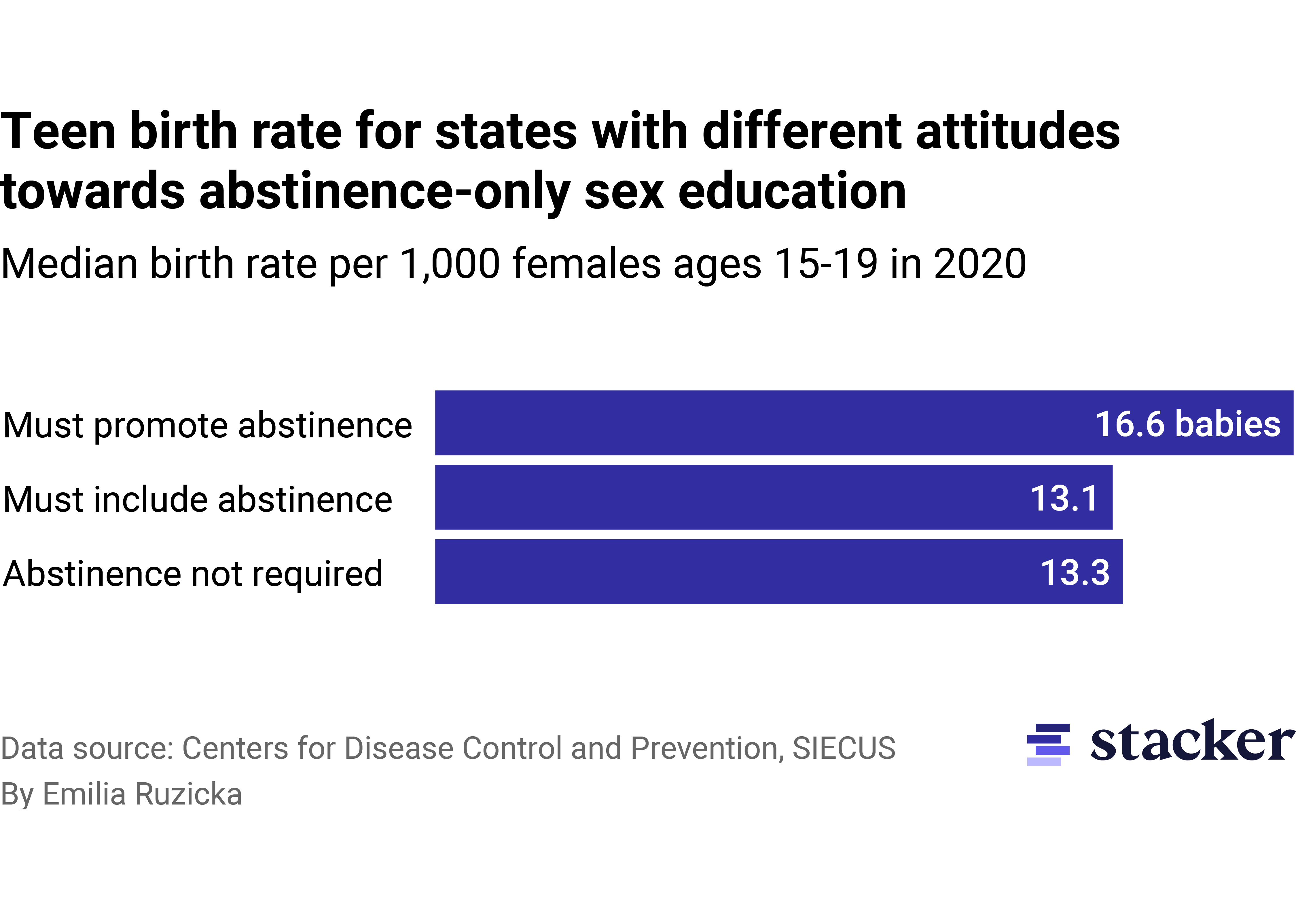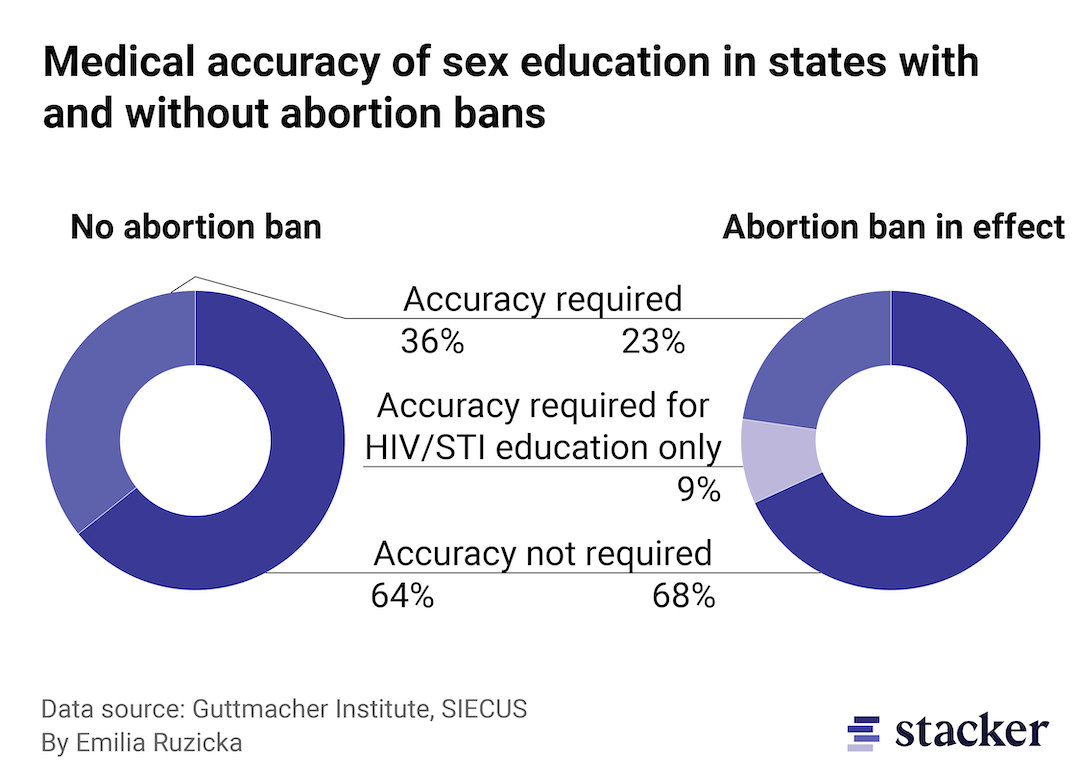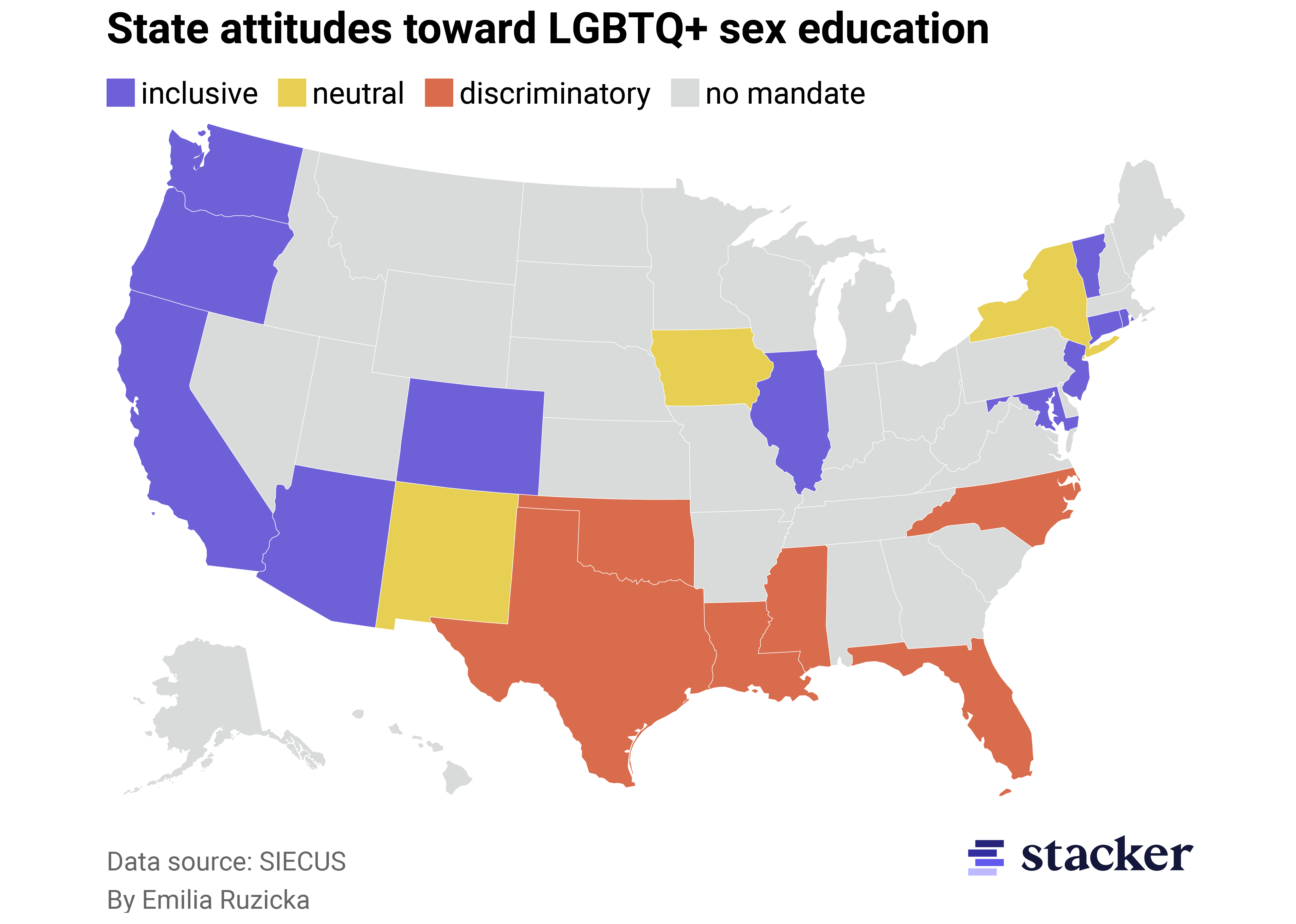Comprehensive sex education matters. Here’s what the data shows

Jacob Lund // Shutterstock
Comprehensive sex education matters. Here’s what the data shows
Female student raising hand in classroom
The gym teacher stands in front of a chalkboard with the word “ABSTINENCE” written in all caps and sternly tells the room of teenagers, “Don’t have sex because you will get pregnant and die.” The scene is a satirical one from the 2004 comedy “Mean Girls,” but the state of sex education in the U.S. is no joke. A patchwork of mandates and philosophies across school districts and states for teaching young people—or not—about sexual health creates discrepancies resulting in wildly disparate health outcomes for teens and young adults.
As the scene from “Mean Girls” suggests, abstinence-based sex education has dominated health classes across the U.S. for decades and remains popular today. Despite this, myriad studies debunk the abstinence-only model. Research by medical professionals and public health experts repeatedly shows that abstinence-only sex ed does not delay young people’s sexual activity, nor has it successfully prevented teen pregnancy or sexually transmitted infections.
In fact, abstinence-only sex ed has proven harmful to youth by not communicating vital health and safety information about sex and the body, and by stigmatizing those who are already sexually active, those who have experienced sexual abuse, and LGBTQ+ students.
Stacker cited data from the Sexuality Information and Education Council of the United States, the Guttmacher Institute, the U.S. Census Bureau, and the Centers for Disease Control and Prevention to visualize how sex education relates to different health outcomes and aspects of daily life. Evidence points to comprehensive sex education as an effective model for teaching young people about sexuality and preparing them to navigate adulthood. Comprehensive sex ed, as defined by the National Sex Education Standards, is medically accurate, LGBTQ+-inclusive, age-appropriate, trauma-informed, and culturally responsive with a focus on defining healthy relationships and consent.
Support is overwhelming for sex ed that teaches young people about contraception, healthy relationships, and STIs, in combination with abstinence, according to public opinion polling from SIECUS. Yet only 38 states and Washington D.C. mandate any kind of sex or HIV/STI education, according to data from the Guttmacher Institute, a reproductive rights policy organization. Just 17 states require sex education to be medically accurate, whereas 39 states plus Washington D.C. require abstinence to be covered if sex ed is taught at all.
The politicization of sex education is not new, but a recent conservative movement has formed in opposition to comprehensive sex education, critical race theory, and the teaching of LGBTQ+ history. Small groups of parents across the country have mobilized to speak out against what former President Trump called “harmful sex- and race-based ideologies.”
This type of politicization of education gets in the way of young people’s access to accurate information, according to Michelle Slaybaugh, the Director of Social Impact and Strategic Communications at the sex education policy and advocacy organization SIECUS. “Parental rights are already at the core of the existing public education system,” Slaybaugh told Stacker in an interview. “We recognize parents have the right to be involved in their child’s education, like any other aspect of their upbringing.” At the same time, she said, “We must remember that the public education system exists to help advance American society by developing critical thinkers.”
The consequences of how sex education is taught go beyond ideology. Real health outcomes—such as teen pregnancy rates, rates of HIV and STIs, and mental health issues—are intertwined with methods of teaching sex ed. While the data cannot speak to direct causation between sex education and health outcomes, it can offer insights into the relationship between the two.
To learn more about sex education laws across the country, read: How sex education is (and isn’t) being taught in every state.
You may also like: From Stonewall to today: 50 years of modern LGBTQ+ history
![]()

Emilia Ruzicka // Stacker
States without mandated HIV/STI education have higher rates of chlamydia, gonorrhea
A bar chart showing the difference in STI rates for states with and without mandated HIV/STI education
Thirty-seven states and Washington D.C. require schools to educate students about HIV and STIs. However, less than half of those states require education to be medically accurate, and there is no standardized curriculum to ensure that students across the country receive equal—or even factual—information about sexually transmitted infections. Thirteen states do not mandate HIV or STI education in schools in any capacity, leaving individual schools to choose whether or not to teach the subject and to what extent.
STI rates have risen nationally for roughly a decade, breaking record highs yearly between 2014 and 2019. The start of the COVID-19 pandemic caused a break in the trend, slowing numbers for the first several months of 2020; however, mid-way through the year, STI rates picked up again, with cases of gonorrhea and syphilis climbing to record numbers. Experts attributed lower STI rates in early 2020 to a combination of underreporting—due to many health clinics being closed during the COVID-19 lockdown—as well as limited spread and contraction of STIs because of decreased sexual contact during isolation.
The rate of STI contraction was not equal across all groups: Teens and young adults aged 15-24 represented more than half of all new STI cases in 2020. In states where HIV/STI education is not mandated, rates of chlamydia and gonorrhea were higher than in states with mandated HIV/STI education. Rates of syphilis, however, were lower in states without mandated HIV/STI education.
While cisgender men who have sex with other cisgender men have had the highest rates of syphilis for some time, the numbers started decreasing in 2020; however, for heterosexual women, syphilis cases grew 147% between 2016 and 2020. Syphilis—sometimes referred to as “The Great Pretender”—can imitate the symptoms of other diseases and can also be asymptomatic, contributing to underreported cases.
Without a national mandate for medically accurate, LGBTQ+ inclusive HIV and STI education, wide discrepancies persist in young people’s access to potentially lifesaving information. Many untreated STIs, as well as HIV, can cause permanent damage to the body and reproductive system, lead to stillbirth, or even result in death. Abstinence-only programs or curricula that exclude LGBTQ+ students leave young people vulnerable to the adverse effects of STIs and HIV.

Emilia Ruzicka // Stacker
States that stress abstinence in sex education have higher teen birth rates
A bar chart showing teen birth rates for states with different attitudes towards abstinence-only sex education
Despite the persistent popularity of abstinence-only sex ed programs in the U.S., teen birth rates in abstinence-only states are significantly higher than in states where abstinence must be mentioned but not emphasized or in states without a mandate on abstinence. These findings suggest that abstinence-only programs are largely ineffective at reducing unintended pregnancies and, in fact, lead to an increase in teen birth rates.
Analyses of abstinence-only programs have revealed them to be scientifically and ethically problematic and point to possible explanations for their correlation with teen birth rates. According to the federal government’s definition of abstinence-only education, these programs are required to omit information about condoms and other forms of contraception, except to emphasize the failure rates of such contraceptives. The omission or distortion of information about the efficacy of condoms and other contraception has been linked to a decrease in contraception use among young people when they do engage in sexual activity.
In addition to not being effective at reducing unintended teen pregnancy, abstinence-only programs can cause harm to young people in other ways. “These types of sex education are often rooted in shame,” Michelle Slaybaugh of SIECUS said. “As educators, as caregivers, our first, primary duty is to do no harm. Abstinence-only tells young people, ‘If you’ve had intercourse prior to marriage, you’re no better than a chewed-up piece of gum.’ This is an actual lesson,” she added.
Slaybaugh said abstinence-only programs leave much to be desired when it comes to teaching young people how to navigate adulthood in safe and healthy ways. That’s why comprehensive sex education, which emphasizes consent and healthy relationships, is so impactful. “When [young people] are not exposed to opportunities to really be able to identify healthy relationships, it puts them at greater risk to experience unhealthy relationships and sexual violence. It doesn’t give young people the opportunity to understand sexuality in a holistic way,” she said.
Abstinence-only programs have dominated the American sex education landscape for over four decades. Beginning in the early 1980s, the federal government bankrolled abstinence-only sex education, codifying funding for these programs under 1996’s Welfare Reform Act. While the U.S. government hasn’t formally published standards for teaching sex education nor mandated that sex education be taught in the first place, it has spent more than $2 billion since 1998 on abstinence-only sex education programs.
This de facto endorsement of abstinence-only programs, as well as the promise of funding, has incentivized these programs over other, evidence-based types of sex education. But conservative states receiving the largest amounts of government funding for abstinence-only sex education have had higher teen birth rates than other states, according to a 2019 study published in the American Journal of Public Health.
During the Obama administration, funding and public support for abstinence-only programs decreased while evidence-based sex education programs received more backing. Between 2008 and 2018, the teen birth rate among all racial groups fell significantly, a decrease partially attributed to pregnancy prevention programs and a slew of cautionary reality TV shows like “16 and Pregnant” and “Teen Mom.” But government funding for evidence-based sex ed didn’t last long. The Trump administration cut funding for these programs and doubled down on abstinence-only education funding, rebranding it as “sexual risk avoidance education” in light of abstinence-only’s waning popularity.

Emilia Ruzicka // Stacker
States not requiring medically accurate sex and HIV/STI education are more likely to have some form of abortion ban
Two donut charts showing the medical accuracy of sex education in states with and without abortion bans
The overturning of Roe v. Wade in June 2022 eliminated federal protections for the right to abortion care across the nation. Some states immediately moved to ban abortion outright, while others imposed increasingly restrictive laws. Abortion is currently banned in 14 states (as of Sept. 20, 2022) and restricted or nearly banned in many others. As states continue to pass legislation restricting abortion access, the need for medically accurate sexual health information has grown.
And yet, many states where abortion is most restricted do not require medical accuracy in sex and STI/HIV education. Ten out of the 14 states with a total abortion ban do not require medically accurate curricula, while one requires medical accuracy only when teaching about HIV. The pattern persists in whether abstinence is stressed and whether contraception is discussed in the classroom; states with more restrictive abortion laws are more likely to stress abstinence and less likely to cover contraception in their sex education programs.
Some states go so far as to prohibit educators from talking to students about abortion as a way of ending a pregnancy. Other states don’t have a mandate for covering abortion, but the political climate of the school or region can make teachers wary of broaching the subject. If there isn’t a mandate, some educators “will opt out for fear of backlash from parents or protesters,” according to Slaybaugh.
And in Texas, the threat of legal action makes teaching about abortion even more of an impossibility. In 2021, the state passed a law deputizing citizens to enforce abortion bans. Under this law, ordinary people can report those who “aid or abet” an abortion and can be rewarded monetarily. This citizen-informant system is a deterrent to adults who might otherwise give teens sexual health resources such as information about abortion.
“Sex education is not the solve for abortion access, because people will get abortions regardless of whether it’s legal or not,” Slaybaugh said. “But, right now, because of the restrictions on abortion, sex education becomes even more vital to young people as an opportunity to access knowledge, skills, and information on how to reduce risk and protect themselves.”

Emilia Ruzicka // Stacker
Sex and HIV/STI education in many states perpetuates derogatory attitudes toward the LGBTQ+ community
A map showing state attitudes toward LGBTQ+ sex education
Representations of sex education in media and pop culture often resemble the abstinence scene from “Mean Girls” or employ comical tropes like using bananas to demonstrate condom usage. Despite being on different sides of the sex education debate, these representations have one thing in common: They promote the idea that sex is always heterosexual—existing only between cisgender men and women—and is limited to penetrative intercourse.
Heteronormative sex education is far from a Hollywood invention. These depictions of sex ed classes mirror the reality in many classrooms in the U.S. to the extent that most exclude LGBTQ+ students entirely. Just 11 states mandate that sex ed be inclusive of members of the LGBTQ+ community, while six actually mandate that sex education curricula negatively depict queer relationships or sexuality. Only 8.2% of students reported receiving inclusive sex education, according to GLSEN’s 2019 School Climate Survey.
A significant portion of young people are affected by non-inclusive sex education. Estimates suggest that 9.5% of U.S. youth aged 13-17 identify as lesbian, gay, bisexual, or transgender; that’s nearly 1 out of every 10 students in that age group, according to the Williams Institute.
The health effects of non-inclusive sex education on queer young people can be physical and psychological, according to Dr. Myeshia Price, the Director of Research Science at The Trevor Project. When sex education does not address issues important to LGBTQ+ youth, “they think, ‘this doesn’t apply to me, I don’t need to listen,'” Dr. Price told Stacker. “They’re missing out on a very crucial and important aspect of their educational experience.”
LGBTQ+ young people face negative health outcomes at disproportionate rates. Queer youth are at higher risk than their heterosexual peers of contracting HIV and other STIs, becoming pregnant or getting someone else pregnant, or experiencing sexual violence. Seventeen percent of those who were out or perceived as transgender left a K-12 school due to mistreatment, according to the 2015 U.S. Transgender Survey.
LGTBQ+-inclusive sex ed can help students understand gender and sexuality as a spectrum, break down harmful stereotypes about LGTBQ+ identities, and teach valuable health information about using protection, regardless of anatomy. Most queer students, however, do not receive this kind of education. “They’re not learning a lot of things that are related to their identities—they’re kind of washed away in terms of the curriculum that they’re getting at school,” Dr. Price said.
Non-inclusive sex education also risks adding to stigmas that have long existed around LGBTQ+ people and diseases like HIV/AIDS. Abstinence-only programs often gloss over the risks of having unprotected sex, while sex ed that is explicitly discriminatory toward LGBTQ+ people—or even neutral toward them—can contribute to the myth of HIV/AIDS as a “gay disease,” leaving students of all sexual orientations and gender identities more vulnerable.
The impact of not receiving medically accurate, inclusive sex education continues to take a toll on the LGBTQ+ community, according to Alexis Rangel, Policy Counsel at the National Center for Transgender Equality/NCTE Action Fund. “The lack of access historically to medically accurate sexual health information has pushed the trans community into a position now where trans folks are more at risk for a lot of negative sexual health outcomes,” she told Stacker. “We see that not only with commonly known STIs and HIV infections, but also with things as recent as monkeypox as well. Access to accurate information is so, so important for the sexual health and the physical health of trans and nonbinary folks.”
The exclusion of young LGTBQ+ people in schools has swelled in recent years, notably with the spate of so-called “Don’t Say Gay” laws. In 2022 alone, more than 162 bills have been introduced that aim to limit LGBTQ+ participation in school sports, restrict curricula from discussing queerness or LGBTQ+ issues, and make it harder for queer teens to access gender-affirming health care.
The mental health consequences of exclusion and discrimination in school can be severe, but LGBTQ+ inclusion has been proven to impact queer youth positively. “Our research has shown that learning about LGBTQ people and issues at school was associated with significantly lower odds of suicide attempts among LGBTQ students,” Dr. Price said. “What this is suggesting is that [when] youth are able to see themselves [in curricula], they’re able to be affirmed in the school environment, and that’s something that is a protective factor from some of the negative health outcomes that we see among LGBTQ youth.”
The need for schools that are inclusive of LGBTQ+ youth is a matter of safety, according to Rangel. “[Trans and nonbinary people] are just a fact of life and a reality,” she said, “and the more we teach our young folks that trans and nonbinary folks exist and dignify the contributions that they’ve made to our society … makes it a safer place.”

Jacob Lund // Shutterstock
Interested in exploring the state-level data yourself?
Closeup of female student hand writing in notebook
Check out the compiled data table on our site to investigate how your state’s sex education and health outcomes compare.
